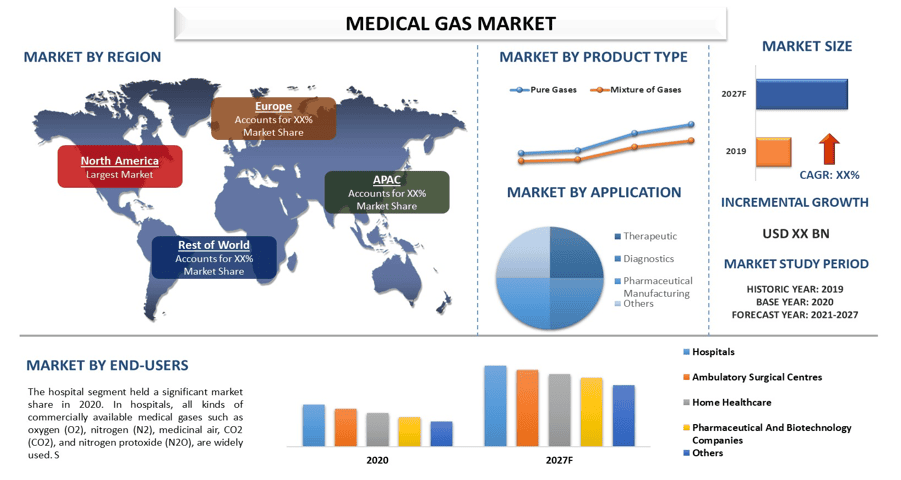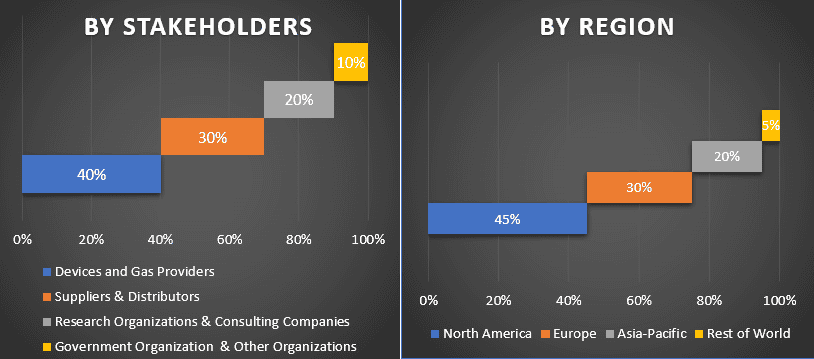- Home
- About Us
- Industry
- Services
- Reading
- Contact Us
Medical Gas Market: Current Analysis and Forecast (2021-2027)
Emphasis on Product Type (Pure Gases and Mixture of Gases), Application (Therapeutic, Diagnostics, Pharmaceutical Manufacturing, and Others), End-users (Hospitals, Ambulatory Surgical Centers, Home Healthcare, Pharmaceutical, and Biotechnology Companies, and Others); Region/Country

Global Medical Gas Market is anticipated to grow with an elevated CAGR of around 7% over the forecast period (2021-2027). Medical gases are a crucial component of the healthcare industry. The gases can be delivered in a variety of methods, including using portable compressed air systems or standalone oxygen cylinders.
The increasing prevalence of chronic diseases globally significantly contributes to the growth of the medical gas market. Chronic obstructive pulmonary disease (COPD) is the third leading cause of death worldwide, causing 3.23 million deaths in 2019. Additionally, the COVID-19 pandemic had a staggering impact on the market for medical gases. In the U.S., the demand for oxygen in hospitals increased by 158% in 2020 and in Europe, the hospital consumption of oxygen was rises up to 98% in the same year. Additionally, rapid growth in the geriatric population and rising incidence of preterm births significantly contribute to the market growth of medical gases in the forecast period.
Air Products and Chemicals, Inc., Linde Group, Air Liquide, Praxair, Inc., Taiyo Nippon Sanso Corp., SOL SpA, Atlas Copco, Messer Group GmbH, and GCE Holding AB are some of the prominent players operating in the Medical Gas market. Several M&As along with partnerships have been undertaken by these players to facilitate customers with new varieties of medical gas devices.
Insights Presented in the Report
“Amongst Product Type, Pure Gases devices segment holds the major share”
Based on product type, the market is categorized into pure gases and a mixture of gases. The pure gases segment held a significant market share in 2020 and it is estimated that it will exhibit a higher CAGR during the forecast period. The growth of this segment is mainly due to the increasing number of patients who require respiratory aid such as patients with asthma, which globally induces the demand for medical gas. Approximately 25 million people in the U.S. have asthma which is about 7% of the population.
“Amongst Application, therapeutic citizen segment holds the major share”
Based on application, the market is bifurcated into therapeutic, diagnostics, pharmaceutical manufacturing, and others. The therapeutic segment grabbed a significant market share in 2020 and is anticipated to grow at a rapid rate in the upcoming years owing to the significant use in the anesthetics such as medical nitrous oxide is used for anesthesia, pain relief, inflating the abdominal cavities during a laparoscopy, and as a refrigerant in cryosurgery. Furthermore, the high prevalence of respiratory and cardiovascular diseases results in increased consumption of medical gases and equipment.
Amongst end-user, Hospital segment holds the major share”
Based on end-users, the Medical Gas market is segmented into hospitals, ambulatory surgical centers, home healthcare, pharmaceutical, and biotechnology companies, and others. The hospital segment is expected to have a significant market share during the forecast period. The growing number of hospitalization cases and the increasing geriatric population owing to the increasing market of the medical gas due to the hospital segment. For instance, as per the WHO, between 2015 and 2050, the proportion of the world’s population over 60 years will nearly double from 12% to 22%. Also, 1 in 6 people in the world will be aged 60 years or over by 2030.
“North America represents one of the largest markets of Medical Gas market”
For a better understanding of the market dynamics of the Medical Gas market, a detailed analysis was conducted for different regions across the globe including North America (U.S, Canada, and the Rest of North America), Europe (Germany, France, Spain, United Kingdom, Italy, and Rest of Europe), Asia-Pacific (China, India, Australia, Japan, and Rest of APAC), Rest of World has been conducted. In 2020, North America had a significant share in the medical gas industry. This can be mainly due to the increasing prevalence of respiratory and chronic diseases as well as the presence of well-established market players significantly contributing to the dominance of the region in the medical gas market.
Reasons to buy this report:
- The study includes market sizing and forecasting analysis validated by authenticated key industry experts
- The report presents a quick review of overall industry performance at one glance
- The report covers an in-depth analysis of prominent industry peers with a primary focus on key business financials, product portfolio, expansion strategies, and recent developments
- Detailed examination of drivers, restraints, key trends, and opportunities prevailing in the industry
- The study comprehensively covers the market across different segments
- Deep dive regional level analysis of the industry
Customization Options:
The global Medical Gas market can further be customized as per the requirement or any other market segment. Besides this, UMI understands that you may have your own business needs, hence feel free to connect with us to get a report that completely suits your requirements.
Table of Content
Research Methodology for the Global Medical Gas Market Analysis (2021-2027)
Analyzing the historical market, estimation of the current market, and forecasting the future market of the global medical gas market were the three major steps undertaken to create and analyze the adoption of various products and devices in the medical gas sector in major regions globally. Exhaustive secondary research was conducted to collect the historical market numbers and estimate the current market size. Secondly, to validate these insights, numerous findings and assumptions were taken into consideration. Moreover, exhaustive primary interviews were also conducted, with industry experts across the value chain of the medical gas market. Post assumption and validation of market numbers through primary interviews, we employed a top-down/bottom-up approach to forecasting the complete market size. Thereafter, market breakdown and data triangulation methods were adopted to estimate and analyze the market size of segments and sub-segments the industry pertains to. Detailed methodology is explained below:
Seek More Details About Research Methodology
Analysis of Historical Market Size
Step 1: In-Depth Study of Secondary Sources:
Detail secondary study was conducted to obtain the historical market size of the medical gas through company internal sources such as annual report & financial statements, performance presentations, press releases, etc., and external sources including journals, news & articles, government publications, competitor publications, sector reports, third-party database, and other credible publications.
Step 2: Market Segmentation:
After obtaining the historical market size of the medical gas market, we conducted a detailed secondary analysis to gather historical market insights and share for different segments & sub-segments for major regions. Major segments included in the report as product type, application, and end-user. Further country-level analyses were conducted to evaluate the overall adoption of medical gas across the globe.
Step 3: Factor Analysis:
After acquiring the historical market size of different segments and sub-segments, we conducted a detailed factor analysis to estimate the current market size of the medical gas. Further, we conducted factor analysis using dependent and independent variables such as the growing number of people with chronic diseases and the increasing elderly population all over the globe. A thorough analysis was conducted for demand and supply-side scenarios considering top partnerships, merger and acquisition, business expansion, and product launches in the Medical Gas sector across the globe.
Seek More Details about Research Methodology –
Current Market Size Estimate & Forecast
Current Market Sizing: Based on actionable insights from the above 3 steps, we arrived at the current market size, key players in the Medical Gas market, and market shares of the segments. All the required percentage shares split, and market breakdowns were determined using the above-mentioned secondary approach and were verified through primary interviews.
Estimation & Forecasting: For market estimation and forecast, weights were assigned to different factors including drivers & trends, restraints, and opportunities available for the stakeholders. After analyzing these factors, relevant forecasting techniques i.e., top-down/bottom-up approach was applied to arrive at the market forecast about 2027 for different segments and subsegments across the major markets globally. The research methodology adopted to estimate the market size encompasses:
- The industry’s market size, in terms of value (US$) and the adoption rate of medical gas across the major markets domestically
- All percentage shares, splits, and breakdowns of market segments and sub-segments
- Key players in the medical gas market in terms of products offered. Also, the growth strategies adopted by these players to compete in the fast-growing market
Market Size and Share Validation
Primary Research: In-depth interviews were conducted with the Key Opinion Leaders (KOLs) including Top Level Executives (CXO/VPs, Sales Head, Marketing Head, Operational Head, and Regional Head, Country Head, etc.) across major regions. Primary research findings were then summarized, and statistical analysis was performed to prove the stated hypothesis. Inputs from primary research were consolidated with secondary findings, hence turning information into actionable insights.
Split of Primary Participants in Different Regions

Market Engineering
Data triangulation technique was employed to complete the overall market estimation and to arrive at precise statistical numbers of each segment and sub-segment of the medical gas market. Data was split into several segments & sub-segments post studying various parameters and trends in the areas of product type and application of the Medical Gas market.
The main objective of the Medical Gas Market Study
The current & future market trends of medical gas were pinpointed in the study. Investors can gain strategic insights to base their discretion for investments on the qualitative and quantitative analysis performed in the study. Current and future market trends determined the overall attractiveness of the market at a regional level, providing a platform for the industrial participant to exploit the untapped market to benefit as a first-mover advantage. Other quantitative goals of the studies include:
- Analyze the current and forecast market size of medical gas in terms of value (US$). Also, analyze the current and forecast market size of different segments and sub-segments
- Segments in the study include areas of product type, application, and end-users.
- Define and analysis of the regulatory framework for the medical gas industry
- Analyze the value chain involved with the presence of various intermediaries, along with analyzing customer and competitor behaviors of the industry
- Analyze the current and forecast market size of the medical gas market for the major region
- Major regions studied in the report include North America, Europe, Asia-Pacific and Rest of the world
- Company profiles of the medical gas market and the growth strategies adopted by the market players to sustain in the fast-growing market
- Deep dive regional level analysis of the industry
Related Reports
Customers who bought this item also bought










